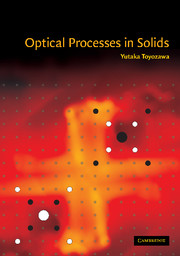Book contents
- Frontmatter
- Contents
- Preface
- Acknowledgments
- List of principal symbols
- 1 Radiation field
- 2 Quantum mechanics
- 3 Interaction of radiation with matter
- 4 Electronic vs. nuclear motions and the optical spectra of localized electrons in solids
- 5 Lattice vibrations
- 6 Electric susceptibility and dielectric constant
- 7 One-electron states in solids
- 8 Excitons
- 9 Polaron and the self-trapped state
- 10 Optical spectra of exciton in the phonon field Overview
- 11 Higher-order optical processes
- 12 Inner-shell excitation
- 13 Photo-induced structural changes
- 14 Light, matter and life (A scenario for the origin of life and its evolution)
- Appendix 1 Derivation of exciton Hamiltonian from many-body Hamiltonian
- Appendix 2 Transient spectra for second-order optical processes
- References (by chapter)
- Subject index
9 - Polaron and the self-trapped state
Published online by Cambridge University Press: 10 December 2009
- Frontmatter
- Contents
- Preface
- Acknowledgments
- List of principal symbols
- 1 Radiation field
- 2 Quantum mechanics
- 3 Interaction of radiation with matter
- 4 Electronic vs. nuclear motions and the optical spectra of localized electrons in solids
- 5 Lattice vibrations
- 6 Electric susceptibility and dielectric constant
- 7 One-electron states in solids
- 8 Excitons
- 9 Polaron and the self-trapped state
- 10 Optical spectra of exciton in the phonon field Overview
- 11 Higher-order optical processes
- 12 Inner-shell excitation
- 13 Photo-induced structural changes
- 14 Light, matter and life (A scenario for the origin of life and its evolution)
- Appendix 1 Derivation of exciton Hamiltonian from many-body Hamiltonian
- Appendix 2 Transient spectra for second-order optical processes
- References (by chapter)
- Subject index
Summary
Polarons in ionic crystals
The behavior of an electron in polarizable medium has a long history of study with versatile developments in condensed matter physics. In 1933 Landau conceived of the self-trapping of an electron in a potential field of polarization induced by itself (digging its own hole, so to speak) as a possible origin of the color center in alkali halides (see Sections 4.7 and 4.8), recognized by their strong absorption bands in the visible region. Although the color center itself turned out later to be an electron at a lattice defect, his idea was further developed by Pekar, Fröhlich, Lee and Pines, Feynman and others, partly stimulated by the field-theoretical approaches to an electron in a self-induced electromagnetic field in a vacuum, and was applied to similar or related problems in condensed matter physics. We shall describe some of these developments and applications in this chapter, with the use of the dielectric theory developed in Chapters 5 and 6.
Let us consider the fluctuating electric field in an isotropic insulator caused by lattice vibrations. The fluctuation–dissipation theorem allows us to express it in terms of the dielectric dispersion as follows. In the absence of an external charge, eq. (1.1.3) with D = ∈eE + P gives ∈ek · Ek = –k · Pk. The polarization density P due to lattice vibrations causes electrostatic potential ø(r) through E = – ∇ø(r).
- Type
- Chapter
- Information
- Optical Processes in Solids , pp. 149 - 191Publisher: Cambridge University PressPrint publication year: 2003
- 1
- Cited by

